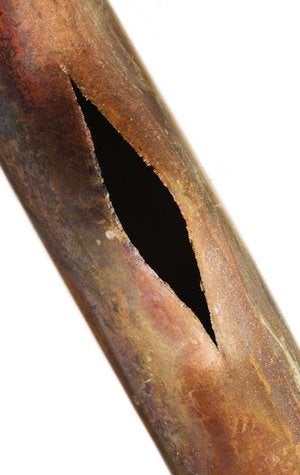When temperatures plummet, pipes can freeze, causing at least some inconvenience, and in the worst case scenario, a burst pipe can cause significant disruption and expense. Learn the signs of freezing and how to thaw them out before any real damage occurs.
Of all the problems encountered during a harsh winter, frozen pipes are probably the most dreaded in the average homeowner’s mind.
That’s because when the temperature drops sufficiently, the water in the pipes freezes and expands, potentially causing them to burst. Hours or even days later, when the freeze subsides, water can flow out of the ruptured pipe, exposing you to all sorts of dangers.
Fortunately, however, there is some good news. Not all frozen pipes will burst and cause leaks. Not all frozen pipes burst and cause leaks. If you find a problem in your home, you may be able to thaw a frozen pipe early enough to prevent damage. Often, you will find frozen pipes when you turn on a faucet and no water comes out, or when you flush the toilet and no water comes out. The pipes themselves may also show signs of freezing, such as swollen pipes or a thin layer of frost covering the pipes.
The key here is timing. If the weather forecast indicates that temperatures are likely to stay low, you may have time to contract with a local plumber to safely handle the situation. However, if temperatures are expected to rise in the near future, or if you simply can’t reach a qualified professional quickly, thaw frozen pipes yourself, perhaps using some household items you already have, by following these steps.
The first step.
Sometimes the hardest part is simply finding the frozen pipe. One trick is to turn on all the faucets in your home. If the water doesn’t reach a particular faucet, trace its plumbing lines away from that fixture. Every few feet, check the pipes by hand (frozen pipes are literally as cold as ice) and continue checking until you find the affected area. If none of the faucets have any water flowing, the problem may be in the main water supply line. You can usually find yours on the side of the house facing the road, in the basement or in a crawl space.

Step two.
Once you’ve located the frozen pipe, turn the main water supply valve clockwise to the “off” position. Next, open all sink faucets and bathtub faucets in your home to drain any remaining water. Flush the toilet in the same way. Return to the frozen pipes with the bucket, mop and two or three towels that can get dirty.
Step Three.
At this point, your task is simple. You apply heat to the frozen pipes. To do this, homeowners often use things like hair dryers, heat lamps and heating pads. Low-tech solutions are just as effective. For example, you can lay a towel over a frozen area and pour hot water over it. More important than the heat source is the technology. It is best to start heating from the edge of the frozen area, starting from the side closest to the kitchen or bathroom. This way, any steam or water generated by the heating can escape from the pipes. Continue to gradually heat the frozen portion of the pipe. Alternatively, if you can’t heat the frozen pipe directly, try running a space heater at the nearest accessible location. Another method. Raise the temperature of the thermostat a few degrees. The increase in utility costs is negligible compared to the cost of expensive repairs.
Step four.
Once you are sure the freeze has melted, go back to the main water valve and turn it partially on. Then go back to the pipe work and check for leaks. If they have burst, turn off the water again, contact a plumber, and proceed with the cleanup. On the other hand, if the pipes appear to be functioning properly, go ahead and turn the water supply all the way back on and turn off any faucets or spigots that are still open.
To prevent a similar situation in the future, take steps to protect any dangerous pipes. There are several ways to do this in the average home, and they do not involve repiping or modifying the heating system. At the very least, consider insulating the pipes in the coldest parts of the house, such as the basement, crawl space, attic and garage, if not all of them. In addition, you can install an appliance called a heat tape to keep pipes from freezing. At the very least, if you know bitter cold weather is coming, you can open the cabinets under the sink to warm exposed pipes by a few degrees. As a last resort, slightly open all faucets and spigots to allow water to flow through the pipes. With this advance preparation, you should never have to crawl through a cold, damp basement with a hair dryer in hand again.










